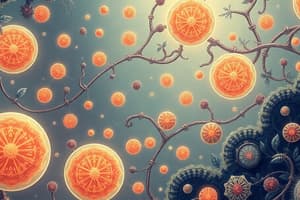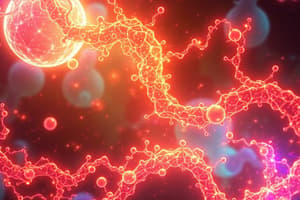Podcast
Questions and Answers
What is metabolism primarily composed of?
What is metabolism primarily composed of?
- A single enzymatic reaction
- A network of metabolic reactions (correct)
- A linear transport system
- A simple diffusion process
Where does metabolism primarily occur?
Where does metabolism primarily occur?
- In a laboratory setting
- In the atmosphere
- Outside of living organisms
- In living cells (correct)
How are metabolic reactions generally organized?
How are metabolic reactions generally organized?
- In a simple arrangement
- Randomly and chaotically
- In a static state
- Well-organized and regulated (correct)
Which of the following is a class of biomolecule involved in metabolic reactions?
Which of the following is a class of biomolecule involved in metabolic reactions?
What is the role of metabolite precursors in metabolism?
What is the role of metabolite precursors in metabolism?
What is the primary function of metabolism regarding nutrients?
What is the primary function of metabolism regarding nutrients?
What do phototrophs, such as plants, use to drive the synthesis of organic molecules?
What do phototrophs, such as plants, use to drive the synthesis of organic molecules?
What do heterotrophs, such as animals, use as building blocks?
What do heterotrophs, such as animals, use as building blocks?
Why is normal metabolism vital?
Why is normal metabolism vital?
What role do enzymes play in metabolic reactions?
What role do enzymes play in metabolic reactions?
What is the function of hormones about enzyme activity?
What is the function of hormones about enzyme activity?
What is a metabolite?
What is a metabolite?
In a reversible metabolic reaction, how many enzymes are required?
In a reversible metabolic reaction, how many enzymes are required?
What is a key characteristic of irreversible metabolic reactions?
What is a key characteristic of irreversible metabolic reactions?
Which biochemical reaction involves the addition of water?
Which biochemical reaction involves the addition of water?
What is a metabolic pathway?
What is a metabolic pathway?
What may some enzymes in metabolic pathways form?
What may some enzymes in metabolic pathways form?
What does compartmentalization of metabolic pathways allow an organism to do?
What does compartmentalization of metabolic pathways allow an organism to do?
What characterizes catabolic pathways?
What characterizes catabolic pathways?
Which of the following describes anabolic pathways?
Which of the following describes anabolic pathways?
Catabolic pathways converge to what?
Catabolic pathways converge to what?
Anabolic pathways diverge to do what?
Anabolic pathways diverge to do what?
What term describes pathways that serve in both catabolism and anabolism?
What term describes pathways that serve in both catabolism and anabolism?
What is the function of the regulation of metabolic pathways?
What is the function of the regulation of metabolic pathways?
What is a common method of metabolic regulation?
What is a common method of metabolic regulation?
What is feedback inhibiton?
What is feedback inhibiton?
What is feedforward activation?
What is feedforward activation?
What is one reason regulation mechanisms exists for anabolic and catabolic pathways?
What is one reason regulation mechanisms exists for anabolic and catabolic pathways?
What may a defect in enzymes and hormones cause?
What may a defect in enzymes and hormones cause?
What does a congenital deficiency of any single Enzyme of a metabolic pathway lead to?
What does a congenital deficiency of any single Enzyme of a metabolic pathway lead to?
Flashcards
What is Metabolism?
What is Metabolism?
A network of metabolic/biochemical reactions that occur in living cells in a well-organized, integrated and regulated manner.
What does Metabolism do?
What does Metabolism do?
The sum of chemical changes converting nutrients to energy, complex substances to simpler forms, and simple substances into complex biomolecules.
What are Phototrophs?
What are Phototrophs?
Organisms (plants) that use light to synthesize organic molecules.
What are Heterotrophs?
What are Heterotrophs?
Signup and view all the flashcards
Why is Normal Metabolism important?
Why is Normal Metabolism important?
Signup and view all the flashcards
What is a Metabolite?
What is a Metabolite?
Signup and view all the flashcards
What is a Metabolic Reaction?
What is a Metabolic Reaction?
Signup and view all the flashcards
What are Reversible Reactions?
What are Reversible Reactions?
Signup and view all the flashcards
What are Irreversible Reactions?
What are Irreversible Reactions?
Signup and view all the flashcards
What is a Metabolic Pathway?
What is a Metabolic Pathway?
Signup and view all the flashcards
What are Catabolic Pathways?
What are Catabolic Pathways?
Signup and view all the flashcards
What are Anabolic Pathways?
What are Anabolic Pathways?
Signup and view all the flashcards
What are Amphibolic Pathways?
What are Amphibolic Pathways?
Signup and view all the flashcards
What is Metabolic Pathway Regulation?
What is Metabolic Pathway Regulation?
Signup and view all the flashcards
What is Feedback Inhibition?
What is Feedback Inhibition?
Signup and view all the flashcards
What is Feedforward Activation?
What is Feedforward Activation?
Signup and view all the flashcards
How do hormones regulate?
How do hormones regulate?
Signup and view all the flashcards
Modes of enzyme regulation.
Modes of enzyme regulation.
Signup and view all the flashcards
What causes Abnormal Metabolism?
What causes Abnormal Metabolism?
Signup and view all the flashcards
Defects in normal metabolism
Defects in normal metabolism
Signup and view all the flashcards
What is Derangement?
What is Derangement?
Signup and view all the flashcards
Inborn Error of Metabolism
Inborn Error of Metabolism
Signup and view all the flashcards
Study Notes
- Metabolism is a network of interconnected metabolic/biochemical reactions that occur within living cells in an organized, integrated, and regulated manner.
- Metabolism is related to various biomolecules, including carbohydrates, lipids, proteins, and nucleoproteins.
- Metabolism involves the interconversion of chemical compounds within the body.
- Metabolite precursors are transformed into end products through specific intermediates.
- Metabolism is the sum of chemical changes that convert nutrients into energy, complex cell substances into simpler forms, and simple substances into functional complex biomolecules.
- Normal metabolism is vital for health, growth, reproduction, and survival.
- Enzymes, along with coenzymes, biocatalyze specific metabolic reactions, making enzymes functional units of metabolism.
- Hormones are chemical messengers of the human body that regulate enzyme activity by either stimulating or inhibiting.
- Enzyme reactions are organized into distinct pathways.
- A metabolite is a substrate or reactant undergoing a biochemical or metabolic reaction.
- A metabolic reaction is a biochemical reaction where a metabolite is specifically reacted by an enzyme and coenzyme to yield a product.
Types of Metabolic Reactions
- Reversible reactions require the same enzyme and are not regulatory steps.
- Irreversible reactions require a different set of enzymes, are non-equilibrium reactions, and are regulatory steps.
Types of Biochemical Reactions.
- Oxidation/Dehydrogenation/Hydroxylation
- Reduction
- Hydrolytic
- Carboxylation
- Decarboxylation
- Phosphorylation
- Dephosphorylation
- Amination
- Deamination
- Isomerization
- Hydration
- Dehydration
- A metabolic pathway is a series of well-defined and significant biochemical reactions that occur sequentially, yielding intermediate products and a final end product.
- Pathways consist of sequential steps
- Enzymes in pathways can be separate or form a multienzyme complex or a membrane-bound system.
- Multienzyme complexes are more common than previously thought.
Compartmentalization of Pathways
- Permits the integration and regulation of metabolism.
- Cytosol: Glycolysis, Pentose Phosphate Pathway, Fatty Acid Synthesis
- Mitochondrial Matrix: Citric Acid Cycle, Oxidative Phosphorylation, β-Oxidation of Fatty Acids, Ketone-Body Formation
- Interplay of Both Compartments: Gluconeogenesis, Urea Synthesis
Phosphoryl-group Transfer
- Involves compounds like Phosphoenolpyruvate, Phosphocreatine, and Glucose 6-phosphate, playing a role in energy transfer within cells.
Types of Metabolic Pathways
- Catabolic pathways are degradative, energy-generating, and ATP-producing, and are exothermic. They involve oxidative reactions that produce reducing equivalents like NADH+H+ and FADH2, converging to a few end products.
- Anabolic pathways are synthetic, energy-utilizing, and ATP-using, and are endothermic. They diverge to synthesize many biomolecules.
- Some pathways serve in both catabolism and anabolism, known as amphibolic pathways, which occur at the crossroads of metabolism and link anabolic and catabolic pathways.
- Regulation of metabolic pathways involves stimulation and inhibition as per cellular needs.
- Hormones regulate metabolic pathways, allowing the organism to respond to changing conditions.
- Every metabolic pathway has specific regulatory or key enzymes.
- Hormones regulate pathways by stimulating or inhibiting the regulatory/key enzymes.
Modes of Metabolic Regulation
- Allosteric regulation
- Covalent modification
- Control of enzyme levels
- Compartmentalization
- Metabolic specialization of organs
Feedback and Feedforward Mechanisms
- Feedback inhibition occurs when the product of a pathway downregulates the activity of an early step.
- Feedforward activation occurs when a metabolite produced early in the pathway activates a downstream enzyme.
- Anabolic and catabolic pathways involving the same compounds are not identical; some steps may be common to both, but others must differ to ensure spontaneity.
- This difference allows regulation mechanisms to selectively activate one pathway and deactivate the other.
Modes of Enzyme Regulation
- Alteration in membrane permeability.
- Conversion of Inactive to Active form.
- Stimulation of mRNA translation.
- Induction of new mRNA formation.
- Repression of mRNA formation.
- Knowledge of normal metabolism is essential for understanding adaptations to starvation, exercise, pregnancy, lactation, and metabolic disorders.
- Abnormal metabolism can result from nutritional deficiencies, enzyme defects, hormonal defects, and drug/toxin interactions.
- Normal enzyme and hormone activities promote normal metabolism and health; defects in enzymes and hormones disrupt normal metabolism.
- Any defect or derangement in the normal pattern of metabolism results in metabolic disorders.
- Mutation in genes of enzymes leads to the formation of defective enzymes.
Inborn Errors of Metabolism
- Congenital deficiency of a single enzyme in a metabolic pathway leads to inborn errors of metabolism.
- Enzyme deficiency in a metabolic pathway blocks the metabolic reaction and the entire pathway.
- The deficiency leads to the accumulation and excretion of intermediate products, prevents the formation of end products, and affects other interrelated metabolic pathways.
Methods Used to Study Metabolism
- Using whole organism/Cellular fractions
- Using Metabolic Probes.
- Using Radioisotopes.
Studying That Suits You
Use AI to generate personalized quizzes and flashcards to suit your learning preferences.




